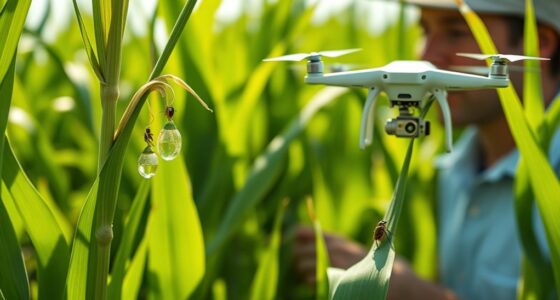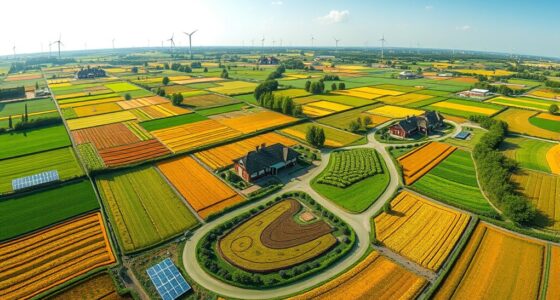Regenerative agriculture uses innovative techniques like cover cropping to restore soil health and boost biodiversity. By planting cover crops such as clover, vetch, or rye, you prevent erosion, improve soil structure, and feed beneficial microbes. These practices create resilient ecosystems that improve water retention and reduce chemical use. Over time, you’d transform land into a self-sustaining system, supporting long-term productivity. Keep exploring to discover how these methods can help heal the Earth naturally.
Key Takeaways
- Regenerative agriculture employs cover cropping and organic matter management to enhance soil microbiomes and restore ecological balance.
- Technologies like composting, biofertilizers, and microbial inoculants support soil biodiversity and nutrient cycling.
- Use of no-till farming minimizes soil disturbance, promoting microbial habitats and soil structure.
- Precision agriculture tools optimize input use, reducing chemical reliance and preserving soil health.
- Integrated crop-livestock systems and ecological practices foster resilient ecosystems and long-term soil regeneration.

Have you ever wondered how farming can restore the health of the land rather than degrade it? The answer lies in practices that nurture the soil rather than exhaust it. One key method is understanding and enhancing soil microbiomes—the diverse communities of bacteria, fungi, and other microorganisms that live in the soil. These tiny organisms play a crucial role in plant health, nutrient cycling, and organic matter decomposition. When you adopt regenerative practices, you support these microbiomes, which in turn improves soil structure, boosts fertility, and increases resilience against pests and droughts. This process is fundamentally different from conventional agriculture, which often strips away organic matter and disrupts these vital microbial communities.
Supporting soil microbiomes through regenerative practices enhances soil health and resilience naturally.
Cover cropping is a highly effective tool in this approach. Instead of leaving fields bare after harvest, you plant specific cover crops like clover, vetch, or rye. These plants don’t just prevent erosion; they actively contribute to building healthy soil. As cover crops grow, their roots penetrate deep into the soil, creating channels that improve aeration and water infiltration. When you terminate these crops, they decompose, releasing organic matter that feeds soil microbiomes. This organic matter becomes the foundation for a thriving ecosystem beneath your feet. Cover cropping also suppresses weeds naturally, reducing the need for chemical herbicides, and can help fix nitrogen, decreasing reliance on synthetic fertilizers.
By integrating cover cropping into your farming routine, you foster a living soil environment that continually regenerates itself. The increased organic matter and microbial activity create a more resilient soil system capable of supporting healthy plant growth year after year. Additionally, cover crops attract beneficial insects and pollinators, which contribute to biodiversity on your farm. This diversity is essential for creating a balanced ecosystem that can withstand pests and diseases without heavy chemical intervention. Over time, the soil’s physical properties improve—becoming darker, more crumbly, and better at retaining moisture—further supporting plant health and reducing irrigation needs.
In essence, nurturing soil microbiomes through cover cropping and other regenerative techniques transforms your land into a self-sustaining system. You’re not just growing crops—you’re restoring the land’s natural capacity to heal itself. This approach goes beyond mere yield improvements; it rebuilds ecological balance, enhances biodiversity, and secures the long-term productivity of your farm. By choosing these regenerative methods, you actively participate in healing the Earth, turning your farm into a vibrant, thriving ecosystem.
Frequently Asked Questions
How Does Regenerative Agriculture Impact Water Conservation?
Regenerative agriculture improves water conservation by enhancing water retention and soil moisture. When you adopt practices like cover cropping and reduced tillage, you help the soil hold more water, reducing runoff and erosion. This means your land stays moist longer during dry periods, conserving water. As a result, you use less irrigation, support healthier ecosystems, and increase resilience against droughts, making your farm more sustainable and productive over time.
Are There Economic Incentives for Adopting Regenerative Practices?
Yes, you can open significant economic benefits by adopting regenerative practices. Policy incentives often provide financial support, making it more appealing to shift your methods. These incentives, combined with improved soil health and biodiversity, lead to higher yields and lower input costs over time. The true surprise lies in how these practices not only protect the environment but also boost your farm’s profitability, turning sustainability into smart business.
What Are the Biggest Challenges to Implementing Regenerative Agriculture?
You face challenges like initial costs and knowledge gaps when implementing regenerative agriculture. Maintaining soil carbon and enhancing biodiversity preservation require consistent effort and understanding. Limited access to advanced technologies or incentives can slow adoption. Additionally, adjusting traditional practices takes time, and you might encounter skepticism. Overcoming these hurdles involves education, support, and demonstrating long-term benefits, making it easier to commit to practices that restore soil health and boost biodiversity.
How Quickly Can Soil Health Improvements Be Observed?
You can often notice soil health improvements within a few months, especially with practices like crop rotation that replenish soil nutrients. As you implement regenerative techniques, you’ll see better soil structure, increased fertility, and enhanced biodiversity over time. While some changes happen quickly, more significant improvements in soil nutrient levels and overall health may take a year or more, depending on your starting point and consistency in applying these practices.
Can Regenerative Techniques Be Integrated With Conventional Farming?
Yes, you can integrate regenerative techniques with conventional farming. Start by incorporating cover cropping to protect and enrich your soil, and practice crop diversification to reduce risks and improve biodiversity. These methods complement traditional practices, enhance soil health, and boost resilience. By blending these approaches, you create a more sustainable system that benefits your land, increases productivity, and promotes long-term environmental health.
Conclusion
By embracing regenerative agriculture, you’re planting seeds of hope that bloom into healthier soils and thriving biodiversity. Think of it as a gentle revolution, restoring the Earth’s vigor one field at a time. Your actions can turn the tide, transforming degraded land into a vibrant tapestry of life. Together, you hold the power to nurture the soil beneath your feet and secure a greener, more resilient future for generations to come.









